A) marginal cost of waiting is less than the marginal benefit of being served.
B) marginal cost of waiting is greater than the marginal benefit of being served.
C) management is exhibiting irrational behaviour by not maximizing profits.
D) management is making an assumption that other things are equal.
Correct Answer

verified
Correct Answer
verified
Multiple Choice
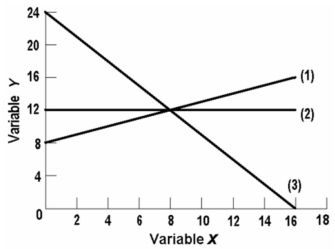 -The linear equation for line (1) on the above graph is:
-The linear equation for line (1) on the above graph is:
A) y = 8 + 2x.
B) y = 8 + .5x.
C) x = 8 + .5y.
D) y = 8 - 2x.
Correct Answer

verified
Correct Answer
verified
Multiple Choice
The concept of opportunity cost:
A) is irrelevant in socialistic economies because of central planning.
B) suggests that the use of resources in any particular line of production means that alternative outputs must be forgone.
C) is irrelevant if the production possibilities curve is shifting to the right.
D) suggests that insatiable wants can be fulfilled.
Correct Answer

verified
Correct Answer
verified
Multiple Choice
Which of the following is a microeconomic statement?
A) The real domestic output increased by 2.5 percent last year.
B) Unemployment was 8.3 percent of the labour force last year.
C) The price of personal computers declined last year.
D) The general price level increased by 4 percent last year.
Correct Answer

verified
Correct Answer
verified
True/False
The fact that economic generalizations are abstract renders them impractical and useless.
Correct Answer

verified
Correct Answer
verified
Multiple Choice
Production possibilities tables for two countries,North Cantina and South Cantina:
North Cantina
Production possibilities (alternatives)
 South Cantina
Production possibilities (alternatives)
South Cantina
Production possibilities (alternatives)
 -Refer to the above tables.If North Cantina is producing at production alternative B,the opportunity cost of the eleventh unit of consumer goods will be:
-Refer to the above tables.If North Cantina is producing at production alternative B,the opportunity cost of the eleventh unit of consumer goods will be:
A) 10 units of capital goods.
B) 1/4 of a unit of capital goods.
C) 8 units of capital goods.
D) 1/8 of a unit of capital goods.
Correct Answer

verified
Correct Answer
verified
Multiple Choice
Unemployment and/or productive inefficiencies:
A) cause the production possibilities curve to shift outward.
B) can exist at any point on a production possibilities curve.
C) can both be illustrated by a point outside the production possibilities curve.
D) can both be illustrated by a point inside the production possibilities curve.
Correct Answer

verified
Correct Answer
verified
Multiple Choice
Assume that a change in government policy results in the increased production of both consumer goods and investment goods.It can be concluded that:
A) the economy was suffering from unemployment and/or the inefficient use of resources before the policy change.
B) the economy's production possibilities curve has been shifted to the left as a result of the policy decision.
C) this economy's production possibilities curve is convex (bowed inward) as viewed from the origin.
D) the law of increasing opportunity costs does not apply in this society.
Correct Answer

verified
Correct Answer
verified
Multiple Choice
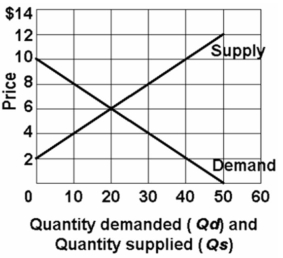 -Refer to the above graph.Which of the following statements is correct?
-Refer to the above graph.Which of the following statements is correct?
A) Quantity demanded and quantity supplied are independent of price.
B) Price and quantity demanded are directly related.
C) Price and quantity supplied are directly related.
D) Price and quantity supplied are inversely related.
Correct Answer

verified
Correct Answer
verified
Multiple Choice
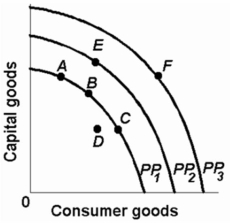 -Refer to the above diagram.Which one of the following would shift the production possibilities curve from PP1 to PP2
-Refer to the above diagram.Which one of the following would shift the production possibilities curve from PP1 to PP2
A) immigration of skilled workers into the economy
B) worsening of the AIDS epidemic
C) an increase in consumer prices
D) a reduction in the age of retirement.
Correct Answer

verified
Correct Answer
verified
Multiple Choice
(The following economy produces two products. )
Production Possibilities Table
 -Refer to the above table.In moving from possibility C to D,the cost of a unit of steel in terms of a unit of wheat is:
-Refer to the above table.In moving from possibility C to D,the cost of a unit of steel in terms of a unit of wheat is:
A) 10
B) 20
C) 25
D) 30
Correct Answer

verified
Correct Answer
verified
Multiple Choice
Which of the following would be most likely to shift the production possibilities curve to the right?
A) a sudden and substantial expansion of consumer wants
B) an improvement in the literacy level and general level of education
C) a decline in the size of the population and labour force
D) shifting resources from butter to gun production
Correct Answer

verified
Correct Answer
verified
Multiple Choice
Which situation would most likely shift the production possibilities curve for a nation in an outward direction?
A) a decrease in the quality of products
B) an increase in the supply of resources
C) a decrease in the state of technology
D) an increase in the amount of discrimination
Correct Answer

verified
Correct Answer
verified
Multiple Choice
The study of economics exists because:
A) government interferes with the efficient allocation of scarce resources.
B) resources are scarce in relation to human material wants.
C) the market system is an obstacle to the efficient use of plentiful resources to satisfy constrained wants.
D) resources are overly abundant as compared to wants;thus,an allocation problem exists.
Correct Answer

verified
Correct Answer
verified
Multiple Choice
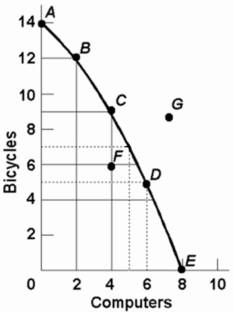 -Refer to the above diagram.The combination of computers and bicycles shown by point F:
-Refer to the above diagram.The combination of computers and bicycles shown by point F:
A) is unattainable,given currently available resources and technology.
B) is attainable,but entails economic inefficiency.
C) is irrelevant because it is inconsistent with consumer preferences.
D) suggests that opportunity costs are constant.
Correct Answer

verified
Correct Answer
verified
Multiple Choice
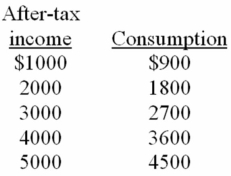 -The above data suggest that:
-The above data suggest that:
A) a policy of tax reduction will increase consumption.
B) a policy of tax increases will increase consumption.
C) tax changes will have no impact on consumption.
D) after-tax income should be lowered to increase consumption.
Correct Answer

verified
Correct Answer
verified
Multiple Choice
When an economist says that material wants are insatiable,this means that:
A) economic resources are valuable only because they can be used to produce consumer goods.
B) economic resources-land,labour,capital,and entrepreneurial ability-are scarce.
C) these wants are virtually unlimited and therefore incapable of complete satisfaction.
D) the structure of consumer demand varies from time to time and from country to country.
Correct Answer

verified
Correct Answer
verified
Multiple Choice
The construction of a production possibilities curve assumes:
A) the quantities of all resources are fixed.
B) technology is fixed.
C) full employment and full production are being realized.
D) all of the above.
Correct Answer

verified
Correct Answer
verified
Multiple Choice
When an economy is operating with maximum efficiency,the production of more of commodity A will mean the production of less of commodity B because:
A) of the law of decreasing opportunity costs.
B) material wants are insatiable.
C) resources are limited.
D) resources are not specialized and are imperfectly substitutable.
Correct Answer

verified
Correct Answer
verified
Multiple Choice
Refer to the diagram below.This production possibilities curve is constructed such that: 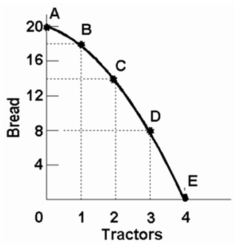
A) resources are presumed to be perfectly shiftable between bread and tractors.
B) the opportunity cost of bread diminishes as more bread is produced.
C) the opportunity cost of tractors diminishes as more bread is produced.
D) the opportunity cost of both bread and tractors in terms of each other increases as more of each is produced.
Correct Answer

verified
Correct Answer
verified
Showing 221 - 240 of 257
Related Exams